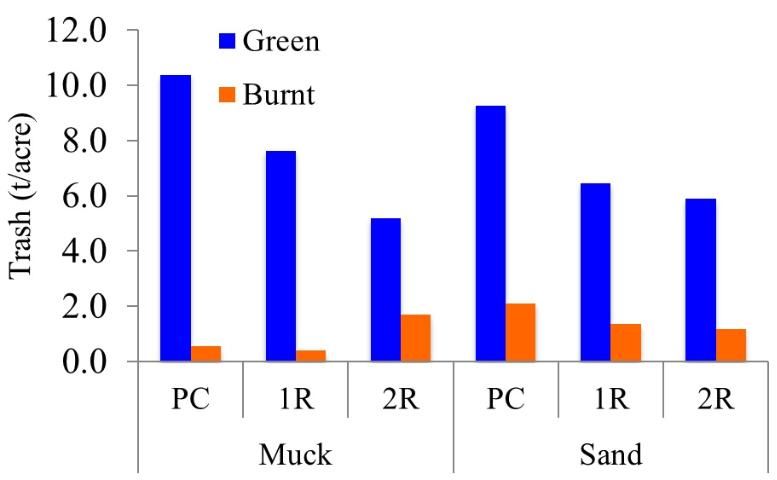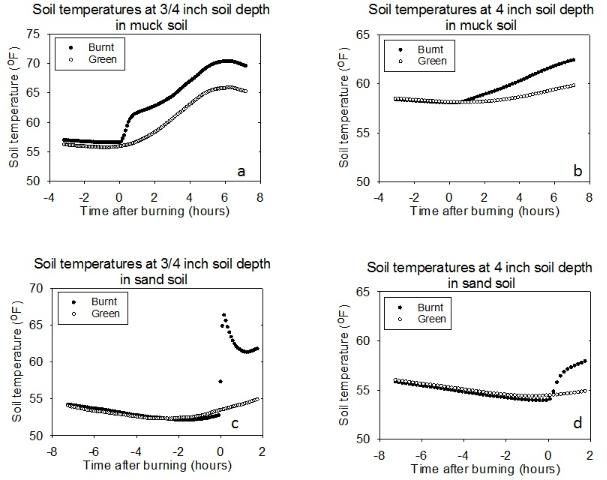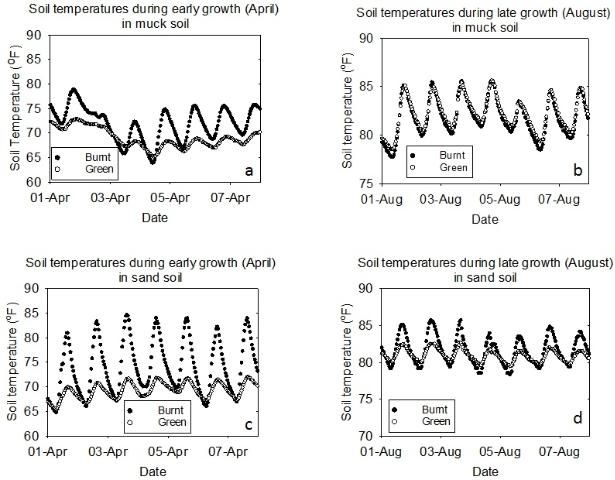The production systems for sugarcane (a complex hybrid of Saccharum spp.) include either green cane or burnt cane harvesting operations. In burnt cane harvesting, sugarcane fields are set on fire in order to burn off leafy material before harvesting in order to reduce transportation costs to the mill, improve harvesting efficiencies, and enhance sugar recoveries at the mill. In green cane harvesting, sugarcane is harvested without burning, and a thick leafy residue (commonly called "trash blanket" or trash) remains on the soil surface.
Sugarcane trash blanket has both negative and positive effects on the emergence and growth of the next sugarcane crop (i.e., ratoon crop). Common negative effects are lower soil temperatures (Oliveira et al. 2001) that delay regrowth of ratoon cane and put young regrowth at risk during subfreezing weather events. Trash blanket also interferes with tillage operations and fertilizer applications. In contrast, positive effects of mulches formed by unburned trash include increased soil carbon, nutrient conservation, reduced weed growth (Samuels and Lopes 1952), and conserved soil water (Ball-Coelho et al. 1993).
Sugarcane in Florida is typically harvested with burnt cane mechanical harvesting. Nonetheless, there is a growing interest to better understand the effects of trash blanket on microclimate conditions for sugarcane growing on both muck (organic soil with >80% organic matter) and sand (mineral soil with <2% organic matter) soils of Florida. A three-year study conducted on muck and sand in the Everglades Agricultural Area (EAA) determined that the effects of harvest method on soil (at 3/4-inch and 4-inch depths) and air temperatures (at 4-inch height from the soil surface) could be different in muck versus sand (Sandhu et al. 2013).
Trash (Harvest Residue)
The amount of trash declined during the multi-year crop cycle, whereby plant cane had the greatest trash followed by progressively less trash for the first ratoon and second ratoon crops (Fig. 1). As expected, green cane harvesting produced much more trash than burnt cane harvesting. The average amount of green cane trash on muck soil (7.7 tons/acre) was comparatively greater than sand (7.2 t/acre), which is attributed to higher sugarcane yields on muck soils. Burning prior to harvest did not completely remove all leafy material and still left some trash on the ground.

Credit: Sandhu et al. (2013)
Soil Temperature during Pre-Harvest Burning
Increases in soil temperature during pre-harvest burning was different in muck soil than sand, and also varied with soil depth. Increase in soil temperature during burning was higher in shallow (3/4 inch) than deep (4 inch) soil (Fig. 2). Also, the increase in soil temperature during burning was higher in sand (10°F–14°F) than in muck soils (5°F–8°F) at 3/4-inch soil depth. At 4-inch soil depth, soil temperatures increased by less than 3°F in muck and by 3°F–7°F in sand soil. This increase indicates that pre-harvest burning of sugarcane may have greater effect on soil microorganisms near the soil surface in sand than in muck soils.

Credit: Sandhu et al. (2013)
Air Temperature
Understanding air temperature differences between green cane and burnt cane harvesting systems is important when assessing microclimate effects on sugarcane regrowth. Air temperatures were recorded at 4 inches above the soil surface to determine if trash had an effect on young emerging sugarcane plant canopies during freezing or near-freezing temperatures. For cold nights where air temperatures were near or below freezing, minimum air temperatures were lower in green cane than in burnt cane plots. Across these different chilly nights, the green cane harvest plots recorded average air temperatures that were colder by 2.2°F in muck and by 2.8°F in sand. These consistent observations indicate that the presence of thick trash blanket with green cane harvest results in colder (and potentially frost-damaging) air temperatures surrounding young sugarcane canopies. Further research needs to be done to determine the effects of different depths of trash layer (created by partially removing the trash) on air temperature near the plant canopy.
Lengths of freeze events ranged from as short as one hour to as long as 12 hours. Air temperatures in green and burnt cane were similar when ambient temperatures were above 40°F, but diverged as ambient temperatures dropped below 35°F. This pattern was consistent across multiple freeze events and soil types, suggesting that the effect of trash on canopy air temperatures is noticeable only when ambient air temperatures are close to freezing (i.e., less than 35°F).
Diurnal Soil Temperature
During early-season growth (April), there was greater diurnal (24-hour) variation in soil temperature (6-inch depth) in both soil types (muck, Fig 3a; sand, Fig. 3c) for burnt cane harvesting. In April, maximum daily soil temperatures were considerably lower in green cane harvest than in burnt cane. However, minimum daily soil temperature differences between green cane and burnt cane treatments were small. These diurnal temperature trends were still evident during the late-growth season (August), but differences between burnt and green cane treatments for diurnal maximum and minimum soil temperatures were appreciably reduced. The insulating effects of crop residues observed during early-season growth in green cane harvest plots were later minimized during late-season growth because of trash decomposition and shading of soil surface by the larger sugarcane crop canopy.

Credit: Sandhu et al. (2013)
In summary, the soil temperature increases that occurred with burning were higher in sand soil than in muck, and this effect dampened with soil depth. Transient (short-lived) soil temperature increases that occurred during the field burning events were smaller than the naturally occurring diurnal soil temperature swings that occurred throughout the growing season. This observation indicates that burn events likely have minimal impacts on soil microflora and microfauna. Young shoots emerging through the green cane harvest trash blanket during winter months will encounter colder air temperatures. This consistent microclimate effect will either delay growth or, in some cases, lead to frost damage, which translates to a loss in seasonal yield potential. Crop canopy damage by frost is more likely to occur with green cane harvest than with traditional burnt cane harvest. Therefore, switching from traditional burnt cane harvest to green cane harvest may have trade-off value for the growers. In the long term, green cane harvest may add organic matter in the soil (important in sand) and reduce soil loss (important in muck). However, there may be some short-term yield losses through delayed growth and frost damage in young plants. The proper management of the excessive trash may reduce the negative effects of trash blanket on sugarcane growth and yield. The ongoing research on trash management includes the evaluation of trash incorporation into the soil through disking, through raking of trash from the row and leaving it in the inter-row space, and through partial removing of trash from the field.
References
Ball-Coelho, B., H. Tiessen, J. W. B. Stewart, I. H. Salcedo, and E. V. S. B. Sampaio. 1993. "Residue management effects on sugarcane yield and soil properties in Northeastern Brazil." Agron. J. 85: 1004–1008.
Oliveira, J. C. M., L. C. Timm, T. T. Tominga, F. A. M. Cassaro, K. Reichardt, O. O. S. Bacchi, D. Dourado-Neto, and G. M. de S. Camara. 2001. "Soil temperature in a sugar-cane crop as a function of the management system." Plant Soil. 230: 61–66.
Samuels, G., and M. A. L. Lopes. 1952. "Influence of handling sugar cane trash on yields and properties." Soil Sci. 74: 207–215.
Sandhu, H. S., R. A. Gilbert, G. Kingston, J. F. Subiros, K. Morgan, R. W. Rice, L. Baucum, J. M. Shine, Jr., and L. Davis. 2013. "Effects of sugarcane harvest method on microclimate in Florida and Costa Rica." Agr. Forest Meteorol. 177: 101–109.